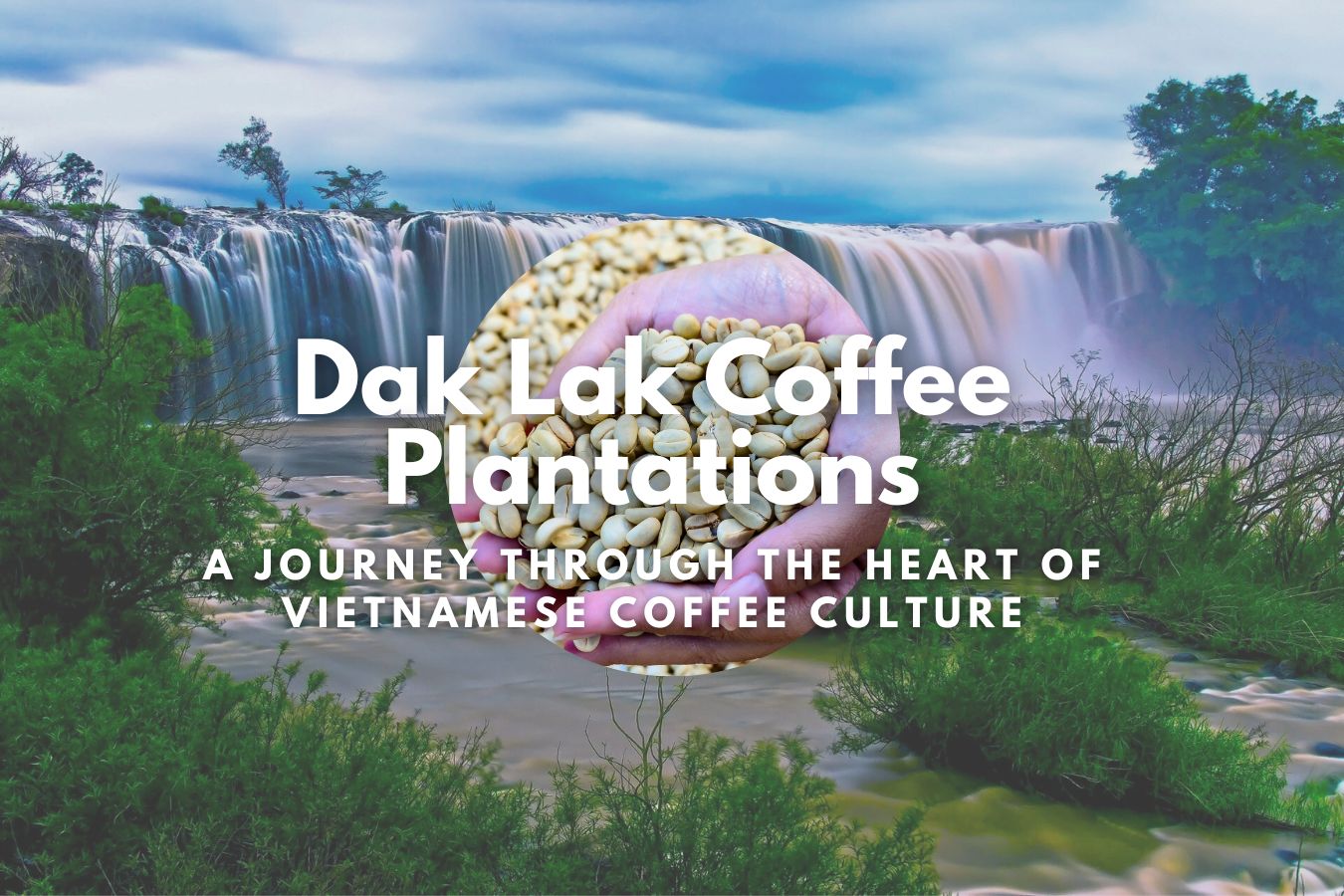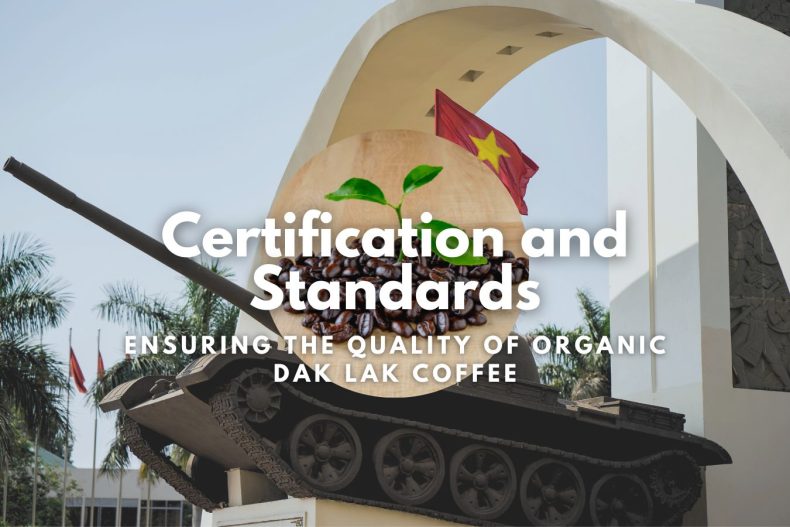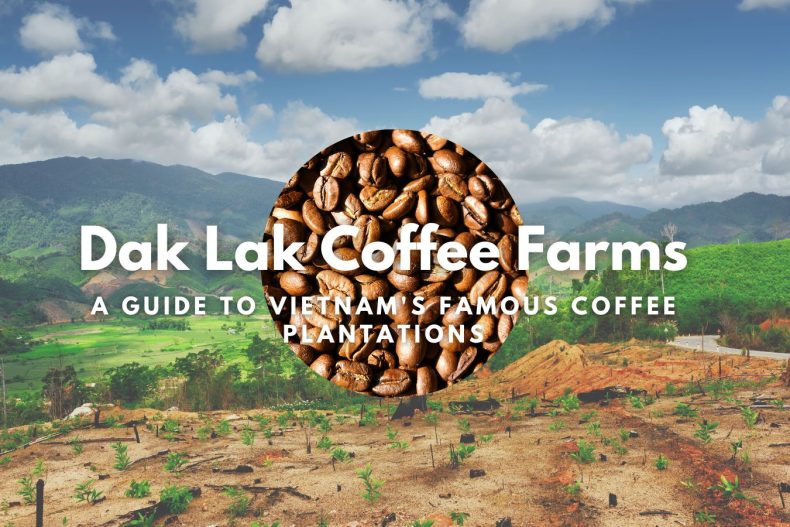
If you’re a coffee lover, chances are you’ve tried Vietnamese coffee at some point. With its robust and sweet flavor and unique brewing method using a phin filter, it’s no wonder that Vietnamese coffee has gained popularity worldwide.
But did you know that much of Vietnam’s coffee is grown in Dak Lak province, in the Central Highlands of Vietnam? In this article, we’ll journey through the heart of Vietnamese coffee culture and explore the fascinating world of Dak Lak coffee plantations.
Introduction to Dak Lak Coffee Plantations
Dak Lak is one of Vietnam’s largest coffee-producing provinces, with over 200,000 hectares of coffee farms. Coffee was first introduced to the area by the French in the early 20th century, and since then, it has become an integral part of the local economy and culture. Dak Lak coffee is known for its unique taste and aroma, influenced by the region’s climate and soil.
History of Coffee in Dak Lak
The first coffee trees were planted in Dak Lak in the 1920s by the French, who saw the potential for coffee cultivation in the area’s high altitude and fertile soil. By the 1950s, coffee had become the main crop in the province, and today Dak Lak produces around 40% of Vietnam’s total coffee output.
Types of Coffee Grown in Dak Lak
Dak Lak is known for its robusta coffee, grown at lower altitudes and used mainly for instant coffee production. However, there is also a growing trend towards arabica coffee cultivation in the region, which is favored by specialty coffee roasters for its complex flavor profile.
Coffee Growing Regions in Daklak Province, Vietnam: A Hub of Robusta Production
Daklak Province, situated in the Central Highlands of Vietnam, is one of the country’s premier coffee-growing regions, renowned for its high-quality Robusta beans. Blessed with fertile soil, a suitable climate, and abundant water resources, Daklak Province provides the perfect environment for coffee cultivation. Some of the key coffee-growing areas within the province include:
Buon Ma Thuot
As the capital city of Daklak Province, Buon Ma Thuot is often called the “coffee capital” of Vietnam. The area is well-known for its large-scale coffee plantations and contributes significantly to the country’s overall Robusta production. Buon Ma Thuot’s coffee is celebrated for its distinct flavor profile, featuring a robust and full-bodied taste with hints of chocolate and caramel.
Coffee trees in Dak Lak are now grown mainly in the coffee geographical indication Buon Ma Thuot area with an area of 213,000 ha, the largest in the country (accounting for more than 30% of the country’s area), the average yield is more than 27 quintals/ha, annual output is about 530,000-540,000 tons of green coffee.
Krong Buk District
Krong Buk district is located in the north of Dak Lak province. Krong Buk district has 7 commune-level administrative units, including Pong Drang town and 6 communes: Chu Kbo (district capital), Cu Ne, Cu Pong, Ea Ngai, Ea Sin, Tan Lap.
The district name is named after Krong Buk Stream, a flowing stream.
The whole district of Krong Buk has over 20,560 hectares of coffee, about 50% of which was planted more than 20 years ago and is now old and low-yielding and needs to be replanted with new varieties. Over the past years, the Party Committees and authorities of Krong Buk district have actively propagated and mobilized people and businesses to boldly replant coffee gardens, promoting products in a sustainable way to ensure long-term benefits.
In addition, the District People’s Committee also directed the functional sector to widely deploy training courses on coffee replanting and bud grafting techniques to improve perennial orchards for people. Accordingly, the district’s agricultural sector is also linking the re-cultivation of coffee with restructuring this industry. The district’s goal by 2030 will completely replant old and inefficient coffee areas. Thereby gradually creating synchronization from production planning to processing and consumption markets for coffee products.
The re-cultivated coffee areas in the planning area will benefit the growers such as loans, technology transfer, and market access…Through the evaluation, up to now, the whole district has about 2,500 hectares of coffee that have been replanted with new varieties, mainly: TRS1, TR4, TR9, TR11, and TS1. In addition to coffee replanting, many households also arrange a reasonable garden to intercrop other crops, increase income on the same land area, and contribute to diversifying local crops.
The demand for coffee replanting in Krong Buk district is still high, but most households struggle in the capital. Therefore, to achieve high results in coffee replanting, the District People’s Committee should direct specialized agencies and local authorities to build models of adequate replanting, disease prevention and control, intercropping etc. encourage and guide people to implement them. Flexible implementation of policies to keep high-quality seedlings, fertilizers, etc., to help ethnic minority households, policy families, and poor households in the district have conditions for production.
Ea Hleo District
Ea H’leo (Vietnamese: Ea H’leo) is a district (huyện) of Đắk Lắk province in the Central Highlands region of Vietnam. Ea H’leo is between Gia Lai Province and Buôn Hồ District flowing Highway 14. Ea H’leo has great soil fertility, huge forests, and other resources, such as rubber and pepper. The primary income of the population is coffee.
As of 2003, the district had a population of 106,185. The district covers an area of 1,331 km2. The district capital lies at Ea Drăng.
Ea H’leo region has numerous coffee farms producing high-quality Robusta beans. Ea H’leo‘s coffee is known for its robust flavor, high caffeine content, and lower acidity than other regions.
The current total coffee plantation area in the district is 31,122 hectares, an increase of 10,077 hectares compared to 2010. The coffee plantation area has grown steadily over the years, with a particularly significant rise of 27.33% in 2011 due to high coffee prices, averaging 47 million VND/ton. Consequently, many households switched their plantation areas from other crops such as rubber, cashew, and fruit trees to coffee cultivation.
Table. Coffee plantation area in Ea H’leo District from 2010-2014
| Indicator | 2010 | 2011 | 2012 | 2013 | 2014 |
|---|---|---|---|---|---|
| Coffee plantation area (ha) | 21,035 | 28,945 | 30,856 | 31,008 | 31,112 |
| Growth rate (%) | N/A | 27.33 | 6.2 | 0.49 | 0.33 |
Source: Ea H’leo District Agriculture Office
In 2011-2014, the area of coffee trees was relatively stable, but due to climate change, the size of old trees increased, leading to decreased productivity and output. Output in 2014: 65,816 tons compared to the same period last year. 2010 coffee area increased by 10,077 ha, and production increased by 16,235 tons, but yield decreased from 2.64 tons/ha in 2010 to 2.35 tons/ha in 2014.
The total agricultural land area in 2014 was 68,470.77 hectares, accounting for 56.20% of the natural land area. The coffee growing area was 31,122 hectares, accounting for 45.44% of the total area land for agricultural production.
The number of employees in the whole district in 2014 was about 64,759 people, of which 32,658 were involved in agricultural production. Coffee production workers have 22,350 people, accounting for 68.4% of agricultural workers.
Varieties are considered a critical factor in determining coffee production’s yield, quality, and efficiency. Before 2001, most coffee acreage in communes and towns over 15 years old was Voi coffee. Most of the varieties produced were self-incubated and planted by households, so the uniformity of the coffee tree was low. Coffee has a low yield, is not high quality, is susceptible to pests and diseases, is rapidly aging, etc.
In recent years, along with introducing new coffee lines at the Central Highlands Agro-Forestry Science and Technology Institute, the Ministry of Agriculture and Rural Development has been recognized as a national source of varieties such as clones from the Central Highlands. TR4 to TR12 give high yields from 4 to 7 tons/ha, large grain size, and weight (17-25g/100 kernels), high resistance to pests and diseases, concentrated ripening, and convenience for harvesting.
Up to now, in the district, the area using new varieties has increased, accounting for more than 1/3 of the coffee area, thereby showing that there has been a positive change in the proportion of seed sources for coffee growing in recent years.
The district’s coffee processing and preliminary processing situation has changed in a positive direction; there has been an investment in modern machinery and equipment for wet processing, so the rate of wet processing of coffee has increased dryness gradually has decreased over the years. However, the wet processing rate is still low, and the dry processing rate is still standard, so the district’s coffee quality has not been significantly improved.
Coffee Plantation Area by Production Organization Type in Ea H’leo District
Unit: hectares
| Organization Type | 2010 | 2011 | 2012 | 2013 | 2014 |
|---|---|---|---|---|---|
| Households | 16,828 | 23,156 | 24,706 | 24,808 | 24,912 |
| Farms, Cooperatives, Private Enterprises | 4,207 | 5,789 | 6,150 | 6,200 | 6,200 |
| State-Owned | 0 | 0 | 0 | 0 | 0 |
Source: Ea H’leo District Agriculture Office
Krong Nang District
Krong Nang is a district located northeast of Dak Lak Province, another Daklak Province region boasting a thriving coffee industry. The district’s coffee plantations benefit from the area’s favorable climate and rich volcanic soil, which produce high-quality Robusta beans with a bold flavor profile and a smooth, velvety mouthfeel.
The district’s name is named after the Krong Nang River, which flows through the community and is a tributary of the Ba River.
Krong Nang district has 24,558 hectares of coffee, in which the area for products is 22,429 ha, the average yield is about 3 tons/ha, and the output is nearly 67,000 tons/year.
The district pays excellent attention to sustainable development in coffee production, currently implementing the PPI Compact Program. This is a new approach developed and sponsored by IDH (The Sustainable Trade Initiative – IDH), with the participation of JDE Group, VnSAT Project, Import-Export One Member Company Limited 2-9 Dak Lak (Simexco Dak Lak), input suppliers, and local companies/enterprises and agents.
The program is implemented over 7 years towards building a sustainable landscape based on green growth goals, divided into two phases.
- Phase 1: from 2019 – 2020, with an initial scale of 5,200 ha/4,000 households in three communes: Ea Tan, Ea Toh, and Dliêya, has created specific impacts on agricultural production and environmental protection. , ensuring the lives of farmers such as: reducing the number of chemical fertilizers used by 14%, a 17% reduction of irrigation water in coffee production, the income of farmers in the pilot area increased by 30% through intercropping and crop diversification; 100% of the coffee in the pilot area is purchased at a price higher than the market price.
- Phase 2: from 2021 – 2025, the district will expand to 12 communes and townships with a scale of 21,100 ha throughout the community.
Cu M’gar District
Cu M’gar District, nestled in the southern part of Daklak Province, is an emerging coffee-growing region. The district’s coffee farms exploit the area’s ideal growing conditions, including fertile soil and a temperate climate. Coffee from Cu M’gar is known for its pungent aroma, full-bodied flavor, and pleasant aftertaste.
In conclusion, Daklak Province is a vital coffee-producing region in Vietnam. Buon Ma Thuot, Ea Kar District, Krong Ana District, and Cu M’gar District are some of its critical coffee-growing areas. These regions have gained recognition for their high-quality Robusta coffee, celebrated for its unique flavor profiles and strong caffeine content. The thriving coffee industry in Daklak Province has played a significant role in positioning Vietnam as the world’s second-largest coffee producer and the largest Robusta coffee exporter.
Cu M’gar is the name in the Ede language, which is what people called the volcano a long time ago. This is a mountain located in the center of the district.
According to the Department of Agriculture and Rural Development (Agriculture and Rural Development), in Cu M’gar district, there are 36,142 hectares of coffee in the district (an increase of 388 hectares compared to 2016), of which 779 hectares are newly planted, and 1,309 are freshly planted ha of basic construction, 34,054 ha of the coffee business, most concentrated in Ea Tul commune (4,282 ha), Cu Dlie Mnong (4,222 ha), Ea Tar (2,834 ha) and Ea Pok town (2,322 ha)…
Through testing and evaluation, the average coffee yield reached nearly 25 quintals/ha, an increase of 4 quintals/ha compared to the previous crop year; district production is estimated at 85,135 tons, up 13,735 tons to last year’s crop. This is the year when the coffee harvest is high after 3 consecutive years of crop failure in the Cu M’gar district.
From 2014 to now, farmers have replanted about 4,700 hectares of old, low-yielding coffee. People have actively removed plant varieties of unknown origin, yield, and poor quality and replaced them with types with high economic efficiency such as TR4, TR9, TRS1, Green Dwarf…; focus on applying for scientific and technical advances, using fertilizers and pesticides properly to improve crop productivity and efficiency.
Up to this point, farmers and businesses, and cooperatives in the district have completed harvesting coffee in the 2017-2018 crop year.
Under the Republic of Vietnam, Cu M’gar land belonged to Ban Me Thuot and Buon Ho districts, Darlac province. After 1975, the present-day community became part of the Krong Buk district.
The Coffee Harvest in Dak Lak
Coffee harvest season in Dak Lak usually begins in November and lasts until March or April. The coffee cherries are picked by hand and processed to remove the outer layers and reveal the beans inside. The beans are then dried in the sun or using mechanical dryers and sorted according to size and quality.
- Handpicking Coffee Cherries
Coffee cherries are typically picked by hand in Dak Lak, as this allows for greater control over the quality of the harvest. Workers use unique baskets or bags to collect the cherries, which are then taken to the processing plant.
- Processing Methods
Two main processing methods are used in Dak Lak: wet and dry. Damp processing involves removing the outer layers of the coffee cherry using water, while dry processing involves letting the cherries dry in the sun before removing the outer layers.
The Importance of Sustainability in Dak Lak Coffee Production
As the demand for coffee grows worldwide, it’s essential to ensure that coffee production is sustainable and doesn’t harm the environment or local communities. Many coffee growers in Dak Lak are now adopting sustainable farming practices, such as using organic fertilizers and conserving water.
- Sustainable Farming Practices
Sustainable farming practices are becoming increasingly popular in Dak Lak. Many coffee growers use techniques such as intercropping, which involves planting different crops to improve soil health and prevent erosion. Other practices include using compost and natural pest control methods.
- Fair Trade Coffee
Fair trade coffee is becoming more widely available in Dak Lak as growers seek to ensure that they receive a reasonable price for their crops and that workers are treated ethically. Fairtrade certification helps to ensure that coffee growers are paid a minimum price for their beans and that workers are given fair wages and working conditions.
Exploring Dak Lak Coffee Plantations
If you’re interested in learning more about Dak Lak coffee plantations, there are plenty of opportunities to explore the region and meet local growers. Many tour companies offer coffee plantation tours, where visitors can see the coffee harvesting and processing process up close and sample some of the local brews.
- Coffee Tours
There are a variety of coffee tours available in Dak Lak, ranging from half-day excursions to multi-day tours. Visitors can learn about the history of coffee in the region, see the coffee plants up close, and taste different varieties of coffee.
- Homestays
For a more immersive experience, visitors can stay with local coffee growers in one of the many homestays available in the region. This allows visitors to learn more about the daily lives of coffee growers and experience the local culture firsthand.
Why Visit Dak Lak Coffee Plantations?
Here are some reasons why Dak Lak Coffee Plantations should be on your bucket list:
- Unique Coffee Experience
Dak Lak Coffee Plantations offer a unique coffee experience that cannot be found anywhere else. You get to witness the coffee-making process and learn about the different stages of coffee cultivation.
- Authentic Vietnamese Coffee
Vietnam is known for its coffee culture, and Dak Lak Coffee Plantations offer an authentic taste of Vietnamese coffee. You can try different blends of coffee and understand why Vietnamese coffee is so special.
- Scenic Beauty
The coffee plantations in Dak Lak are spread across a hilly landscape, offering stunning views of the surrounding mountains and valleys. You can take a stroll through the plantations and enjoy the scenic beauty.
- Cultural Immersion
Visiting Dak Lak Coffee Plantations is a great way to immerse yourself in Vietnamese culture. You can interact with the locals and learn about their way of life.
- Supporting Local Communities
By visiting Dak Lak Coffee Plantations, you support the local communities that depend on coffee cultivation for their livelihoods. You can also purchase coffee beans and other local products, which helps to boost the local economy.
- Educational Experience
Dak Lak Coffee Plantations offer an educational experience where you can learn about the history of coffee cultivation in Vietnam and the various stages of coffee production. This is an excellent opportunity to expand your knowledge about coffee and its importance in Vietnamese culture.
- Adventure Tourism
Dak Lak Coffee Plantations offer more than just a coffee experience. You can also participate in adventure tourism activities such as hiking, cycling, and zip-lining. This is a great way to explore the region’s natural beauty and get your adrenaline pumping.
Conclusion
Dak Lak Coffee Plantations offer a unique and authentic coffee experience that is not to be missed. From the region’s scenic beauty to the educational experience of coffee cultivation, Dak Lak Coffee Plantations have something for everyone. So, if you are a coffee lover or just looking for a new adventure, add Dak Lak Coffee Plantations to your bucket list.
FAQs
- What is the climate like in Dak Lak?
Dak Lak has a tropical climate, with hot and humid summers and more relaxed, drier winters.
- What is the difference between robusta and Arabica coffee?
Robusta coffee has a more robust, bitter flavor than arabica coffee, known for its complex flavor profile.
- Are there any other crops grown in Dak Lak besides coffee?
Yes, Dak Lak is also known for its rubber and pepper plantations.
- Can visitors purchase coffee beans at the plantations?
Yes, visitors can purchase coffee beans at many of the plantations in Dak Lak.
- What is the best time of year to visit Dak Lak?
The best time to visit Dak Lak is during the coffee harvest season, usually from November to April.


